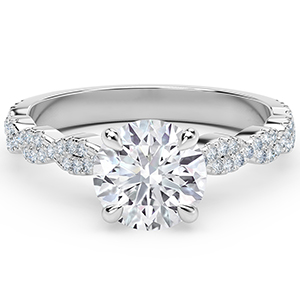
Wedding planning site The Knot has released the 2020 edition of its annual Jewelry and Engagement Study, which tracks trends in consumer behavior and wedding jewelry by polling thousands of recently betrothed couples. And, unsurprisingly, the biggest factor in couples’ planning and ring shopping decisions in 2020 was the COVID-19 pandemic.
The pandemic played a major role in couples’ decision-making, from setting the date and choosing a venue to inviting guests and figuring out how and when to shop for wedding jewelry.
The study of more than 5,000 newly engaged individuals found that COVID-19 pushed proposers to plan their proposals within a shorter time frame this year, to account for “constantly evolving pandemic conditions.” Nearly half of proposers were forced to change original plans as a result of the pandemic, from changing the location (67%) or date (63%) to involving their friends and family (52%).
COVID-19 restrictions also drove engaged couples to meet with jewelers and jewelry consultants online more than ever. Thirteen percent of ring shoppers said they talked to jewelers through online chat boxes or video conferencing platforms when shopping for rings in 2020.
The study also found that betrothed couples are very motivated to tie the knot, despite COVID-19: 8 in 10 newly engaged couples have picked a wedding date, the majority of which are in 2021 (73%), and most (66%, up from 57% in 2019) started planning their wedding within one month of getting engaged.
“Despite challenging times and changes to many original proposal plans due to COVID-19, couples around the nation continued to strengthen and progress their relationships, showcasing how even in the most challenging times love cannot be canceled,” noted Kristen Maxwell Cooper, editor-in-chief of The Knot, in a prepared statement.
Here are a few jewelry-related takeaways from this year’s study:
• The most popular center stone cuts for engagement rings were round (43%), princess (13%), and oval (15%).
• White gold still reigns in engagement. The most popular ring setting metals were white gold (48%), yellow gold (16%), rose gold (13%), and platinum (13%).
• The most popular ring features for those being proposed to were, in order, style and setting, center stone shape, and type of stone (so style trumps stone).
• 48% of rings bought included some customization.
• Diamond weight in rings averaged 1.5 cts. t.w. and 1.3 cts. for the center stone.
• 33% of proposers researched rings online.
• 11% of proposers connected with jewelers via social media.
• Nearly a third of engagement rings were purchased online, although the majority (63%) were still purchased in person at either a local jeweler (51%) or national retailer (33%).
• Due to the restrictions placed by social distancing guidelines and the limited amount of in-store appointments available, proposers visited less retailers (on average 2, down from 3 in 2019), and viewed less rings (8, down from 15 in 2019) before making their selection.
• The national average cost of an engagement ring went down slightly, to $5,500, compared to $5,900 in 2019.
• Engagement ring shopping in 2020 “continued to be a two-person job for most couples,” as 72% of the individuals who were proposed to reported being involved in the selection of their engagement ring.
Top: Forevermark round twisted diamond band engagement ring in white gold, price on request; Forevermark (photo courtesy of Forevermark)
Follow Emili Vesilind on Instagram: @emilivesilind
Follow JCK on Instagram: @jckmagazineFollow JCK on Twitter: @jckmagazine
Follow JCK on Facebook: @jckmagazine